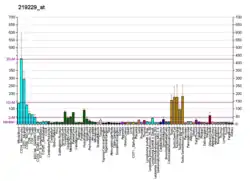Solute carrier organic anion transporter family member 3A1
Solute carrier organic anion transporter family member 3A1 is a protein that in humans is encoded by the SLCO3A1 gene.[5]
| SLCO3A1 | |||||||||||||||||||||||||||||||||||||||||||||||||||
|---|---|---|---|---|---|---|---|---|---|---|---|---|---|---|---|---|---|---|---|---|---|---|---|---|---|---|---|---|---|---|---|---|---|---|---|---|---|---|---|---|---|---|---|---|---|---|---|---|---|---|---|
| Identifiers | |||||||||||||||||||||||||||||||||||||||||||||||||||
| Aliases | SLCO3A1, OATP-D, OATP3A1, OATPD, SLC21A11, OATP-RP3, OATPRP3, solute carrier organic anion transporter family member 3A1 | ||||||||||||||||||||||||||||||||||||||||||||||||||
| External IDs | OMIM: 612435 MGI: 1351867 HomoloGene: 40862 GeneCards: SLCO3A1 | ||||||||||||||||||||||||||||||||||||||||||||||||||
| |||||||||||||||||||||||||||||||||||||||||||||||||||
| |||||||||||||||||||||||||||||||||||||||||||||||||||
| |||||||||||||||||||||||||||||||||||||||||||||||||||
| |||||||||||||||||||||||||||||||||||||||||||||||||||
| |||||||||||||||||||||||||||||||||||||||||||||||||||
| Wikidata | |||||||||||||||||||||||||||||||||||||||||||||||||||
| |||||||||||||||||||||||||||||||||||||||||||||||||||
See also
- SLCO3A1+protein,+human at the U.S. National Library of Medicine Medical Subject Headings (MeSH)
References
- GRCh38: Ensembl release 89: ENSG00000176463 - Ensembl, May 2017
- GRCm38: Ensembl release 89: ENSMUSG00000025790 - Ensembl, May 2017
- "Human PubMed Reference:". National Center for Biotechnology Information, U.S. National Library of Medicine.
- "Mouse PubMed Reference:". National Center for Biotechnology Information, U.S. National Library of Medicine.
- "Entrez Gene: SLCO3A1 solute carrier organic anion transporter family, member 3A1".
Further reading
- Huber RD, Gao B, Sidler Pfändler MA, et al. (2007). "Characterization of two splice variants of human organic anion transporting polypeptide 3A1 isolated from human brain". Am. J. Physiol., Cell Physiol. 292 (2): C795–806. doi:10.1152/ajpcell.00597.2005. PMID 16971491.
- Gerhard DS, Wagner L, Feingold EA, et al. (2004). "The status, quality, and expansion of the NIH full-length cDNA project: the Mammalian Gene Collection (MGC)". Genome Res. 14 (10B): 2121–7. doi:10.1101/gr.2596504. PMC 528928. PMID 15489334.
- Ota T, Suzuki Y, Nishikawa T, et al. (2004). "Complete sequencing and characterization of 21,243 full-length human cDNAs". Nat. Genet. 36 (1): 40–5. doi:10.1038/ng1285. PMID 14702039.
- Adachi H, Suzuki T, Abe M, et al. (2003). "Molecular characterization of human and rat organic anion transporter OATP-D". Am. J. Physiol. Renal Physiol. 285 (6): F1188–97. doi:10.1152/ajprenal.00402.2002. PMID 14631946.
- Schiffer R, Neis M, Höller D, et al. (2003). "Active influx transport is mediated by members of the organic anion transporting polypeptide family in human epidermal keratinocytes". J. Invest. Dermatol. 120 (2): 285–91. doi:10.1046/j.1523-1747.2003.12031.x. PMID 12542534.
- Patel P, Weerasekera N, Hitchins M, et al. (2003). "Semi quantitative expression analysis of MDR3, FIC1, BSEP, OATP-A, OATP-C,OATP-D, OATP-E and NTCP gene transcripts in 1st and 3rd trimester human placenta". Placenta. 24 (1): 39–44. doi:10.1053/plac.2002.0879. PMID 12495658.
- Strausberg RL, Feingold EA, Grouse LH, et al. (2003). "Generation and initial analysis of more than 15,000 full-length human and mouse cDNA sequences". Proc. Natl. Acad. Sci. U.S.A. 99 (26): 16899–903. Bibcode:2002PNAS...9916899M. doi:10.1073/pnas.242603899. PMC 139241. PMID 12477932.
- Tamai I, Nezu J, Uchino H, et al. (2000). "Molecular identification and characterization of novel members of the human organic anion transporter (OATP) family". Biochem. Biophys. Res. Commun. 273 (1): 251–60. doi:10.1006/bbrc.2000.2922. PMID 10873595.
This article incorporates text from the United States National Library of Medicine, which is in the public domain.
This article is issued from Wikipedia. The text is licensed under Creative Commons - Attribution - Sharealike. Additional terms may apply for the media files.




